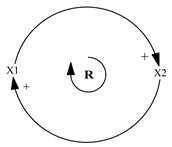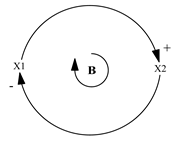Abstract
This paper describes the modeling efforts devoted by the Ministry of Health and Social Services of Québec, Canada (MSSS), to ensure the long-term bearability of their care system. To this end, it studies the relationships between four entities that self-regulate and interact to form the complex care-providing system: (1) universities; (2) hospitals and doctors; (3) the ministry; and (4) society. The first phase of this research focuses on modeling such relationships and relies on the system dynamics methodology to adequately capture the long-term dynamics of the system. The methodology encompasses three phases: (a) determination of the critical variables and parameters of each entity; (b) development of the causal diagram of each entity; and (c) integration of the individual causal diagrams to form the global system diagram. The final casual model illustrates and explains the relationships between all the entities and constitutes an excellent tool to support experts during discussions or focus groups where critical variables that positively or negatively affect the system can be evaluated. We intend to enrich this casual model in a further phase of the project, which will hopefully lead to a simulation and scenario analysis tool that can be used to support managers in their long-term decision-making process.
1. Introduction
The healthcare and social services system offered throughout Québec was created in 1971 following the adoption of a healthcare and social services Act by the National Assembly of Québec [1]. It is a public system, with the State acting as the main insurer and administrator; all residents of the province of Québec are admissible. The plan covers all the basic healthcare services, except some specific treatments such as aesthetic surgery and parallel medical practices known as natural or alternative [2].
In 2012, the entire healthcare expenditure in Québec roughly totaled $43.5 billion. This included both public expenses (including direct expenses covered by the government for the people under its care) and private expenses (amounts claimed from private insurance plans, direct payments—such as contributions to accommodation (CHSLD) and for the purchase of drugs—for example, made by individuals and donations). Public healthcare expenditure, which rose to $30.5 billion in 2012, accounted for 70.2% of the total [1].
Social services expenditure is not included in the estimates of the Canadian Institute for Healthcare Information. It accounts for roughly 12% of the Government of Québec’s total healthcare and social services expenditure. Between 2000 and 2012, public and private healthcare expenditure grew annually by an average of 4.9% and 5.8%, respectively [1].
On the other hand, the higher education institutions are responsible for training medical doctors in Québec; four higher education institutions are financed by the State to provide such training. Since the Act to Modify the Organization and Governance of the Healthcare and Social Services Network—in particular by abolishing the regional agencies—came into force on 1 April 2015, the Québec healthcare and social services network have included the following aspects:
- (a)
- Thirteen integrated healthcare and social services centers (CISSS), and nine university healthcare and social services integrated centers (CIUSSS). Only integrated centers located in a healthcare region where a university offers a complete undergraduate medical program or operates a university institute in the social field are entitled to be called CIUSSS.
- (b)
- Seven institutions that were not amalgamated with an integrated center, of which four are university hospital centers (CHU) and three are university institutes (IU).
- (c)
- Five institutions not covered by the Act, which are offering services to an aboriginal and Northern population.
- (d)
- Each institution may offer services in several sites that are physical locations where healthcare and social services are provided.
- (e)
- It should be noted that 17 institutions that were not amalgamated under the Act have been grouped into integrated centers, and are managed by the center’s board of directors.
- (f)
- In addition to the services provided by public institutions, society benefits from services such as lodging and long-term care that are provided by private institutions.
Moreover, four integrated university healthcare networks (RUIS) promote collaboration and complementarity and fulfill the combined mission of care, education, and research that is incumbent upon the healthcare institutions and higher education institutions with which they are affiliated. These are the Université Laval, McGill University, Université de Montréal, and Université de Sherbrooke integrated higher education institutions healthcare networks [3].
The future capacity of MSSS to satisfy Quebec’s population demand for specialized healthcare depends on the demand (the population) and the available system capacity, which basically depends on the number of available doctors and the number of contracts offered by the MSSS. The number of doctors at a given time t shows a dynamic behavior, that depends on the number of doctors at an initial moment plus the students that graduate from higher education institutions between and , minus the doctors that retire between and . Since specialized training requires between 10 and 12 years, the MSSS must plan today for the number of students starting medical studies, knowing that they will only join the field ten years from now. Similarly, Quebec’s population will change in the next ten years, as it will the current set of doctors. In this context, the aim of this paper is to propose a causal model using the systems thinking approach to support discussions on the challenging task of deciding courses of action such as policies, the number of candidates enrolling medical studies, or the number of contracts to offer, among others, to ensure the long-term bearability of their care system. Bearability concerns the achievement of two of the sustainability pillars: social and environmental. Bearability is targeted in this paper rather than the triple sustainability—social, environmental, and financial pillars—because our goal at this moment is to capture the complex and dynamic relationships between the above-mentioned actors without limiting their choices by external funding constraints. Nonetheless, economic aspects such as funding are of the highest importance for system sustainability and may also impact patients’ behavior and cares consumption [4]. The introduction of economic aspects in further healthcare models will be briefly discussed in Section 5.
2. Literature Review
This section first introduces system dynamics methodology and then presents some studies related to this research. Jay Forrester, the creator of system dynamics methodology, defines it as that which studies data feedback characteristics—mainly within industrial activities—in order to prove how organization structure, policy broadening, and delays (in both actions and decisions) interact and impact the success within the organization. Its subject matter is based on examining the interactions among companies’ information flows, money, orders, materials, staff, and equipment. Moreover, system dynamic provides a single structure to group the functional areas of top management [5].
From another perspective, Sterman [6] establishes system dynamics as a method used to optimize learning within complex systems; it is a method to develop decision-making simulators by means of specialized computer software. The purpose is to know the dynamic complexity within a system, understand the source of policy resistance, and design more effective strategies.
The first phase in system dynamics methodology encompasses the development of a causal model considering exogenous and endogenous variables, as well as parameters that directly impact the behavior of one or more dynamic variables considered within the entities. Information feedback systems are relevant when a meaning leads to a decisive action, whose result is another influential action in the environment, and therefore, impacts future decisions. The feedback process is ongoing, and, therefore, attracts new results which consequently maintain the process in constant movement by using past data to decide or predict future behavior [5,6]. Thus, a causal diagram is a graphically depicted causal diagram which is created based on the elements of a system and its interrelations. It integrates causal loops to explain certain behaviors and incorporates background data to predict future behaviors. It typically has a greater degree of formality than a linguistic description, but it is less precise than a mathematical equation. This type of diagram is comprised of interrelated elements within the system. It also includes the concept of feedback as circular chains of influence, and its presence explains certain behaviors of the model structure [7,8,9].
These causal loops help build the foundations of a systemic language that allow for certain system descriptions to be determined and enable the visualization of things which, without these models and loops, could not be appreciated at a glance. The causal loops diagrams are classified in positive and negative based on their self-regulatory behavior system [7,10]. Table 1 shows the configuration of each type of causal loop diagram.

Table 1.
Causal loop diagrams.
Empirical Studies Related to This Research
A comprehensive, non-exhaustive review of recent literature allowed us to identify several works related to the use of system dynamics or systems thinking to support decision making in healthcare or to the study of sustainability in that particular context. The next paragraphs briefly describe their contributions and position our research with respect to them.
The work of Wolstenholme et al. [11] is one of the first to propose system dynamics models as a new way of understanding how complex healthcare systems operate. They demonstrate the value of such modeling approach, providing a safe environment within which stakeholders from across agencies and functions can make explicit their own assumptions, understand the impact that their initiatives might have on other parts of the system, and develop ways of collaborating to achieve maximum benefit for service users. Since then, system dynamics or systems thinking has been successfully applied to the study of public health services. Indeed, the systematic literature review conducted by Carey et al. [12] reports how system-oriented approaches have been applied, and conclude that soft systems modeling techniques are likely to be the most useful addition to public health, and align well with the current debate around knowledge transfer and policy. Marshall et al. [13] reported recommendations on the potential of dynamic simulation modeling methods to support health care decision-makers evaluating interventions to improve the effectiveness and efficiency of health care delivery. Gupta et al. [14] described the steps needed and data required for analysis of supply and demand from a system perspective. They proposed a modeling tool that allows educators and policy makers, in addition to physician specialty organizations, to assess how various factors may affect demand (and supply) of current and emerging health services. Djanatliev et al. [15] enlarged the scope of methods encompassed by system-oriented thinking by discussing the use of hybrid simulation approaches, consisting of system dynamics (SD) and agent-based simulation (ABS), to anticipate the impacts of an innovative product before it is developed.
System-modeling tools have been applied to facilitate a better understanding of the system-wide effects of patient flow-related interventions. Esensoy and Carter [16] presented a multi-panel expert knowledge elicitation approach based on group model building principles to assess changes to rehabilitation patient flows in a community hospital. Vanderby and Carter [17] proposed a system dynamics model that simulates patient flows in a hospital. The model is used to analyze the delays experienced by patients in the emergency department. Several works have focused, like our research, on the study of a system’s long-term capacity. Vanderby et al. [18] and later Morgan and Graber-Naidich [19] developed models simulating the evolution of the workforce in the long term. While Vanderby, Carter, Latham and Feindel [18] considers a single specialty at a national level, and provides a tool that helps decision managers planning future workforce, Morgan and Graber-Naidich [19] focused on policies to alleviate the rural care gap in the future. Grida and Zeid [20] proposed a system dynamics model simulating a typical hospital where different types of patients are served using the same limited resources. The model is used to study system capacity, and then to identify bottleneck resources.
Sustainability is still an emerging concept in healthcare, although its importance is rising quickly. To the best of our knowledge, sustainability in healthcare systems has been approached through the development of the social pillar, particularly in studies focusing on patient satisfaction and patient-oriented care. Indore [21] proposed a comprehensive conceptual model to understand and measure variables affecting patient satisfaction in an attempt to assess healthcare quality. It suggests a multi-disciplinary approach combining patient input as well as expert judgment to achieve this challenging task. In Faezipour and Ferreira [22], Faezipour and Ferreira discuss healthcare as a complex system of systems and discusses the challenges related to healthcare sustainability. Indeed, by placing patients at the center of the healthcare system, authors focus on patient satisfaction as a means to develop the social pillar of sustainability. Finally, Faggini et al. [23] studied how some digital enablers (e.g., digital technologies and platforms), boost the sustainability of complex service systems such as healthcare. The paper tries, by analyzing the system dynamics, to explain the role of technologies, in particular digital platforms, empowering actors and making them willing to interact and share their own resources in continually new ways as ongoing value co-creation, which is essential for healthcare system sustainability.
We conclude that, despite of the efforts to analyze the dynamics of the healthcare system in a long-term perspective, additional research must be done to better understand the relationships between the four decisional entities suggested in this paper: (1) higher education institutions; (2) the Ministry or the Government; (3) hospitals or healthcare centers; and (4) the society in demand for services, but also as a source of income for the Government as taxpayers. Moreover, sustainability objectives need to be incorporated in an explicit manner to new models and approaches to study healthcare systems.
3. Materials and Methods
This article applies the first phase of system dynamics methodology: it is related to the conceptualization phase supported by causal diagrams to analyze the influences among the four selected entities.
For its analysis, the first stage of the system dynamics methodology was used, which encompasses three phases:
- Determination of the critical variables and parameters for each entity;
- Development of a causal diagram for each entity;
- Integration of the individual causal loop diagram to form the global system diagram from the selected entities.
4. Results
4.1. Determination of the Critical Variables and Parameters for Each Entity
During this first phase, variables and parameters are selected based on theoretical research conducted through empirical studies and stakeholder experience.
Entity 1: higher education institutions. As described in Table 2, nine initial variables and nine parameters have been determined in order to develop the first causal diagram called the role of higher education institutions.

Table 2.
List of variables and parameters for the entity of higher education institutions.
Entity 2: the Ministry. Five initial variables and four parameters have been determined in order to develop the second causal diagram, called Ministry, that describe the funding resources. Table 3 shows this information.

Table 3.
List of variables and parameters for the entity of the Ministry.
Entity 3: hospitals. Five initial variables and five parameters have been determined to develop the third causal diagram called hospitals. Table 4 shows this information.

Table 4.
List of variables and parameters for the entity of hospitals.
Entity 4: Quebec society. Six initial variables and six parameters have been determined to develop the four causal diagram called the role of Quebec society. Table 5 shows this information.

Table 5.
List of variables and parameters for the entity of Quebec society.
4.2. Causal Diagram Development for Each Entity
In this phase, each of the entities is developed considering the variables and parameters; this leads to a better understanding of the influence that each variable has over the other or others. The parameters generate the dynamic for each of the variables involved. Likewise, each of the entities and their explanation are shown separately in each of the following figures.
The entity of higher education institutions is presented in Figure 1, in which four balancing causal loop diagrams, B1 to B4, can be observed.

Figure 1.
Causal loop diagrams for the Higher Education Institutions entity.
Dynamics of balancing loops B1 and B2 are explained as follows: there is an annual population that applies for admission at university to become part of the population of students that will be accepted; however, some of them will be rejected, so this makes the system become balanced (B2). The dynamic of student entries is trapped in the university: the way in which the system is regulated is the capacity of each of the universities in terms of the total number of students it can accept. The balancing loop B3 and B4 establishes that doctor training goes from one stage to the other; as long as it is possible to go from one level to another, there will be greater interest in becoming part of the university; all the students are in universities (higher education institutions) per 4 or 5 years, then they are in residence familiar medicine or residence subspecialties, and then students in the universities are reduced because they now are in other category.
Figure 2 shows the second entity related to hospitals, viewed as entities that receive medical doctors; in this diagram, causal loop B5 expresses negative or balancing relationships, which comes back to the idea set forth by [23].
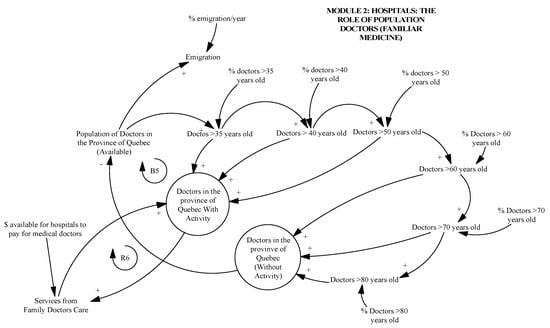
Figure 2.
Causal loop diagrams for the hospitals entity.
The loop B5 generates a dynamic that begins with a growth in the population of available doctors. This growth goes through different stages or population groups defined by the age, in which the dynamic leads to the understanding that, as they become older, doctors tend to be less active, which results in a reduction in the number of “net” available doctors. The R6 loop explains a dynamic switch of services, from available doctors to active doctors once the ministry assigns funds to hospitals to enroll an additional workforce.
Figure 3 shows the third entity that explains the dynamic of Quebec society in terms of population growth and decline, the latter either due to natural reasons or as a consequence of family decisions to enter or leave Quebec.
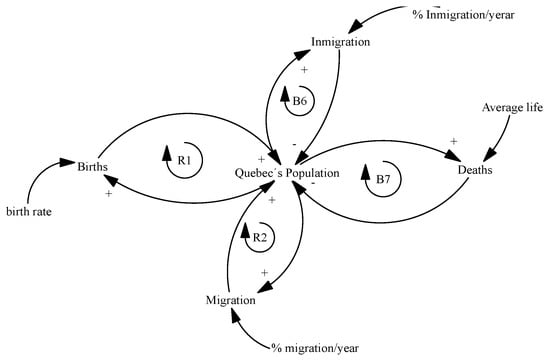
Figure 3.
Causal loop diagrams for the entity of society.
There are two reinforcing (R1 and R2) and two balancing (B6 and B7) loops that are explained next. The population of Quebec grows by the effect of two variables: births (R1) and migration, which can be split into doctors arriving from other provinces of Canada, or those who come from other countries (R2). The Quebec population decreases due to natural deaths (B7) or immigration (B6) when people born in Quebec emigrate to other states or countries.
Finally, the entity related to the Ministry and Government is illustrated in Figure 4. It contains four loops: two balancing loops (B8 and B9) and two reinforcing loops (R3 and R4). In order to explain the dynamic of this entity, it has been set forth that as the economically active population increases, there is greater income for the Ministry as a result of tax payments (R3); this allows medical services in family medicine care to be covered by the Ministry, causing a decrease in resources; nevertheless, there are incoming funds on behalf of organizations that contribute to the rise in funds (B8). This sustains the financial resources in the Ministry in terms of family income and organization contributions (R4). The budget for the universities depends on the total students accepted each year; this is the dynamic presented in loop B9.
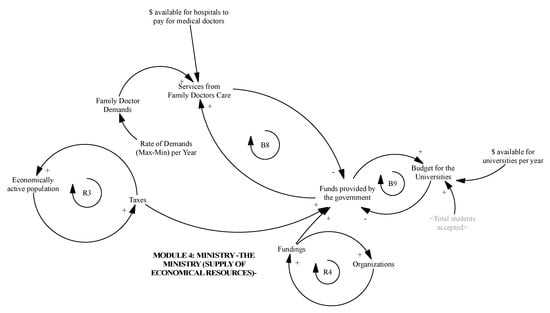
Figure 4.
Causal loop diagrams for the Ministry entity.
This analysis, conducted separately for each of the entities, seeks to make clearer the complexity of the whole system. It considers that a system is a set of an entity and at least two interrelated elements and where each element is related to the others, either directly or indirectly [24,25].
4.3. Integrating Individual Causal Loop Diagrams to form the Global System Diagram
The last phase is the integration of the four entities, which is presented in Figure 5. The purpose is to provide to all the stakeholders with a global view where they can observe their role, and from that perspective, make the necessary adjustments to the model before moving on to its simulation stage.
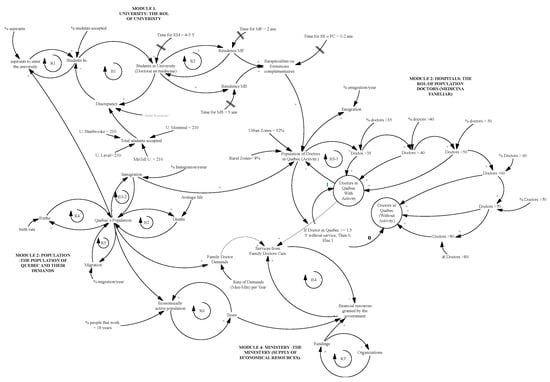
Figure 5.
Causal loop diagram for the whole system, including the four entities.
Systems thinking requires the use of causal loop diagrams to improve understanding of the system [26]; in this sense, after having constructed the entities separately, it is fundamental to visualize them as a whole by joining the parts. The model shows the interactions among the four entities, higher education institutions, society, hospitals, and the Ministry. It is important to observe that, in total, there are nine causal balancing loops (Bi, where i = 1…. 9) and five reinforcing loops (Rj, where j = 1…5).
In order to transform the casual diagram into a simulation model, parameters affecting the relationships as well as initial values for the variables need to be set. A data collection process is therefore required, followed by a validation step before planning numerical experiments that would help to analyze the system’s sensitivity to specific decisions or policies. However, casual diagrams support fertile discussions among stakeholders. Also, notice that focal groups must concentrate on each entity, and the discussion must be coordinated by a group of people external to the entity—but having a good knowledge of all of them—in order to achieve favorable results in the final version that will lead to the second phase of the solution development from a quantitative point of view.
5. Discussion
The usage of system dynamics, in their first step related to conceptualization (causal loop diagrams), represents an opportunity for organizations dedicated to providing services to society. In this project, the four selected entities have been studied separately and then merged into a single model. The following considerations are raised for discussion:
- The model integrates data gathered from official websites, which must be validated by the stakeholders of the areas involved.
- The model is built from a theoretical and qualitative perspective, based on the fact that the variables are consolidated from empirical studies, and the model is conceptual, incorporating variables and parameters that are explained from the perspective of the system dynamics theory.
- The model only covers the first phase of the system dynamics, which is related to the conceptualization phase and divided into three stages.
- Nonetheless, to validate the entire model, it is necessary to question and verify the interrelations among the four entities.
Using systems thinking allows us to conceive causal diagrams of specific behaviors and to connect several of them later to form a more complex system. This process allows a better understanding of the system and its entities. The granularity of the model’s components is, however, a decision of the model designer and, since there is no fixed rule to do it, it makes systems thinking a science but also an art.
Finally, it is worth mentioning that both financial aspects and demand modeling for health services and its evolution in forthcoming years by considering the emergent risks or changes in the way that healthcare is provided, as approached by [21], is a key part of healthcare system design and we are considering such a demand model entity in our next version of the model.
6. Conclusions
Based on the analysis of variables and parameters included in the feedback model to observe the complexity of the same in the four entities, that is, the universities as educators that train medical doctor in family medicine, hospitals as spaces where they are able to provide their services to the community integrated by the Quebec society, and the Ministry as the entity that manages financial resources from taxpayers and organizations that are part of society, it can be concluded that:
- It is possible to understand the complexity of each entities’ functions and their role from a systemic perspective supported by cause–effect interrelations provided by causal diagrams.
- The ministry may allocate funds to universities and hospitals based on the information provided by the scenarios that arise from quantitative analysis with a dynamic simulation that should be developed from the proposed feedback model.
- The system dynamics methodology in their first step (causal loop diagrams) provides information at every stage in order to better understand the complexity of the entities as a whole.
- The present work contributes to the Ministry’s decision-making process; it is a graphic representation that enables following the cause–effect relationships of each entity.
- The model may be replicated in other countries that have the four entities analyzed in the Province of Quebec, Canada, with all its required adjustments.
Future Work
The Project has been concluded in its first phase, which is related to the conceptualization of the system under study by using the dynamic systems methodology. The second part is building a simulation model and conducting a sensitivity analysis in order to show future scenarios by implementing “what if” policies and know the pessimist and optimist scenarios after validating the current one. The third phase corresponds to the development of a graphic interphase in which users can run tests by means of certain general-use buttons to observe data, graphs and performance indicators that are worth analyzing in the four entities under study.
Author Contributions
Conceptualization, methodology, software, and formal analysis, E.A.L.-L.; supervision, AR; writing—original draft preparation, E.A.L.-L. and A.R.; writing—review and editing, A.R.
Funding
This research was funded by Federal Program of Mexico (PFCE-2019) and CONACYT, through National Laboratory for Transportation System and Logistics.
Acknowledgments
The authors E.A.L.-L. and A.R., as part of the National Laboratory in Transportation and Logistics- Consolidation Systems, the authors are grateful for the support received through the National Science and Technology Council of Mexico (CONACYT) through the “National Laboratories” program. This Publication was funded with PFCE 2019 as a part of the international stay at Laval University, Canada. Also, with complementary founds provided by PROFAPI-2019-ITSON.
Conflicts of Interest
There is no conflict of interest. The funding sponsors had no role in the design of the study; in the collection, analyses, or interpretation of data; in the writing of the manuscript; and in the decision to publish the results.
References
- MSSS. © Gouvernement du Québec 2019. Obtenido de Ministère de la Santé et des Services sociaux. Available online: http://www.msss.gouv.qc.ca/en/reseau/systeme-de-sante-et-de-services-sociaux-en-bref/contexte/ (accessed on 17 June 2019).
- International, Q. Quebec en la cabeza. Available online: https://www.quebecentete.com/es/vivir-en-la-ciudad-de-québec/salud/ (accessed on 19 July 2019).
- Québec, G.D. Organization of the Healt and Social Services Network; Éditeur officiel du Québec: Québec, QC, Canada, 2019. [Google Scholar]
- Vuong, Q.; Ho, T.; Nguyen, H. Healthcare consumers’ sensitivity to costs: A reflection on behavioural economics from an emerging market. Palgrave Commun. 2018, 4, 70. [Google Scholar] [CrossRef]
- Forrester, J. Dinámica Industrial, Segunda ed.; Editorial El Ateneo: Patagones, Argentina, 1981. [Google Scholar]
- Sterman, J. Business Dynamics: Systems Thinking and Modeling for a Complex World; McGraw Hill: New York, NY, USA, 2000. [Google Scholar]
- Aracil, J.; Gordillo, F. Dinámica de Sistemas; Alianza: Madrid, Spain, 1997. [Google Scholar]
- Senge, P.; Roberts, C.; Ross, R. La Quinta Disciplina en la Práctica: Estrategias y Herramientas Para Construir la Organización Abierta al Aprendizaje; Ediciones Granica: Buenos Aires, Argentina, 2006. [Google Scholar]
- Guo, H.; Qiao, W.; Liu, J. Dynamic Feedback Analysis of Influencing Factors of Existing Building Energy-Saving Renovation Market Based on System Dynamics in China. Sustainability 2019, 11, 273. [Google Scholar] [CrossRef]
- Lagarda, E. Collection and Distribution of Wheat, Dynamic of the Process of Shipping to International Markets: Case Study. Int. J. Supply Chain Manag. 2019, 8, 43–57. [Google Scholar]
- Wolstenholme, E.; McKelvie, D.; Smith, G.; Monk, D. Using System Dynamics in Modelling Health and Social Care Commissioning in the UK. In Proceedings of the 2004 International System Dynamics Conference, Oxford, UK, 25–29 July 2004. [Google Scholar]
- Carey, G.; Malbon, E.; Carey, N.; Joyce, A.; Crammond, B.; Carey, A. Systems science and systems thinking for public health: A systematic review of the field. BMJ Open 2015, 5. [Google Scholar] [CrossRef] [PubMed]
- Marshall, D.; Burgos-Liz, L.; IJzerman, M.J.; Osgood, N.D.; Padula, W.V.; Higashi, M.K.; Wong, P.K.; Pasupathy, K.S.; Crown, W. Applying dynamic simulation modeling methods in health care delivery research-the SIMULATE checklist: Report of the ISPOR simulation modeling emerging good practices task force. Value Health 2015, 18, 5–16. [Google Scholar] [CrossRef] [PubMed]
- Gupta, S.; Black-Schaffer, W.S.; James, M.; Gross, D.; Donald, S.; Kaufman, J.; Knapman, D.; Prystowsky, M.B.; Wheeler, T.M.; Bean, S.; et al. An Innovative Interactive Modeling Tool to Analyze Scenario-Based Physician Workforce Supply and Demand. Acad. Pathol. 2015, 2. [Google Scholar] [CrossRef] [PubMed]
- Djanatliev, A.; Kolominsky-Rabas, P.; Hofmann, B.M.; Aisenbrey, A.; German, R. System Dynamics and Agent-Based Simulation for Prospective Health Technology Assessments. In Simulation and Modeling Methodologies, Technologies and Applications. Advances in Intelligent Systems and Computing; Obaidat, M., Filipe, J., Kacprzyk, J., Pina, N., Eds.; Springer: Berlin/Heidelberg, Germany, 2014; Volume 256. [Google Scholar]
- Esensoy, A.; Carter, M. Health system modelling for policy development and evaluation: Using qualitative methods to capture the whole-system perspective. Oper. Res. Health Care 2015, 4, 15–26. [Google Scholar] [CrossRef]
- Vanderby, S.; Carter, M. An evaluation of the applicability of system dynamics to patient flow modelling. J. Oper. Res. Soc. 2010, 61, 1572–1581. [Google Scholar] [CrossRef]
- Vanderby, S.; Carter, M.; Latham, T.; Feindel, C. Modelling the future of the Canadian cardiac surgery workforce using system dynamics. J. Oper. Res. Soc. 2014, 65, 1325–1335. [Google Scholar] [CrossRef]
- Morgan, J.; Graber-Naidich, A. Small system dynamics model for alleviating the general practitioners rural care gap in Ontario, Canada. Socio-Econ. Plan. Sci. 2019, 66, 10–23. [Google Scholar] [CrossRef]
- Grida, M.; Mahmoud, Z. A System Dynamics-Based Model to Implement the Theory of Constraints in a Healthcare System. Simulation 2019, 95, 593–605. [Google Scholar] [CrossRef]
- Indore, A.N. Factors affecting patient satisfaction and healthcare quality. Int. J. Health Care Qual. Assur. 2009, 22, 366–381. [Google Scholar] [CrossRef]
- Faezipour, M.; Ferreira, S. A System Dynamics Perspective of Patient Satisfaction in Healthcare. Procedia Comput. Sci. 2013, 16, 148–156. [Google Scholar] [CrossRef]
- Faggini, M.; Cosimato, S.; Nota, F.D.; Nota, G. Pursuing Sustainability for Healthcare through Digital Platforms. Sustainability 2019, 11, 165. [Google Scholar] [CrossRef]
- Van Gigch, J. Teoría General de Sistemas, 3rd ed.; Trillas: Veracruz, Mexico, 2012. [Google Scholar]
- Ackoff, R. El Paradigma de Ackoff: Una Administración Sistémica; Limusa: Mexico City, Mexico, 2002. [Google Scholar]
- Richardson, G.; Pugh, A., III. Introduction to System Dynamics Modeling with Dynamo; Pegasus Communications: Whaltan, MA, USA, 1981. [Google Scholar]
© 2019 by the authors. Licensee MDPI, Basel, Switzerland. This article is an open access article distributed under the terms and conditions of the Creative Commons Attribution (CC BY) license (http://creativecommons.org/licenses/by/4.0/).
